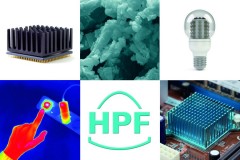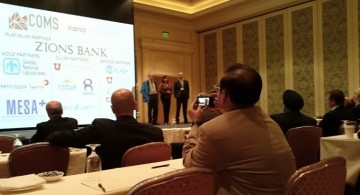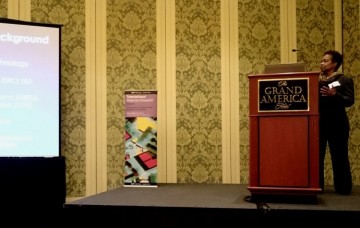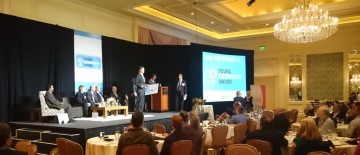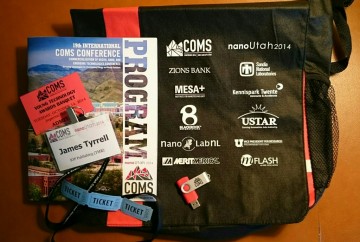A guest post for TMR+ by Douglas Paul, professor of semiconductor devices at the University of Glasgow and director of the James Watt Nanofabrication Centre
Douglas Paul was awarded the President’s Medal at the Institute of Physics (IOP) awards dinner on 15 October, in recognition of his achievements in translating physics research into advanced technology.
Acceptance speech
Madam President, Distinguished Guests, Ladies and Gentlemen, colleagues
I am extremely honoured to be standing here and accepting the President’s medal from the Institute of Physics.
After seeing past recipients have included Brian Cox, Tim Berners-Lee, Michael Atiyah and Lord Dainton you are probably all wondering who is Douglas Paul and why is he getting the President’s Medal?
I have always modelled my career on Louis Pasteur – undertaking research to solve major problems that at some level benefit society. This has not always got publications in the high impact journals that is required to advance ones career, but it has allowed me to interact with an enormous number of UK and international companies.
My PhD at Cambridge and my first funded research grant were both about finding ways to reduce the power consumption of the transistors in microchips. This work on strained-Si MOSFETs is now in every major microprocessor being produced today. I was one of the first to suggest straining channels but lost the race to be first to deliver high performance devices. The experience taught me a lot!
The EC funding for the work press-ganged me into compiling the Technology Roadmap for European Nanoelectronics in 1999. I had little idea it was going to be taken into the industrial International Technology Roadmap of Semiconductors forming the first Future Emerging Technologies chapter in 2005.
This got me my first interaction with the IOP when I ended up in the House of Lord’s giving evidence to the House of Lord’s Enquiry into “Chips for Everything” in May 2002. Later I became a member of the Science Board and helped to lobby government on science policy.
David King whilst GCSA to Tony Blair brought me into the Home Office CBRN Scientific Advisory Committee in 2004 after I had written a DTI report on security and medical imaging along with having DARPA funding for THz work.
Little did I realise when I said yes to being on this committee that it would be involved in the 7/7 bombing reviews, shoot to kill policy, airports liquids ban, Litvinenko and many other incidents not in the public domain.
I am frequently asked why a physicist is involved in so much security? National security requires technology that can detect threats – either imaging technology or sensors. The science is heavily based on quantum mechanics and electromagnetism and so physicists are essential to the National Security of the UK.
We have many examples of physicists in security in this room. Our President Francis Saunders, a physicist ended up as the Chief Executive of the UK’s Defence Scientific Technology Laboratory and Peter Knight who is also here tonight and a former president has chaired the MOD’s Defence Scientific Advisory Council (DSAC).
Indeed it was Peter who interviewed me when I became a member of MOD’s DSAC and we walked around Warminster with full body armour and a half pack to understand the problems dismounted solders were facing in Afganhistan. I have pushed with others trying to get a modern science and engineering capability around MOD and DSTL that can provide the UK with the scientific capability to meet the threats of tomorrow.
In 2007 I moved to Glasgow so that I could get access to a far better cleanroom for research than any of the ones in Cambridge. Three years later I became the Director of that cleanroom, the James Watt Nanofabrication Centre and within 2 weeks of landing the job had to develop a strategy and business plan to drive it forward.
It has been a delight to be Director and publicise some of the original research of my colleagues including the first directed STEM cell growth using nanopatterns – now in clinical trials for self-repairing hip-joint replacements, lab-on-a-pill (now spun out into a prostate cancer probe start-up) and the development of 10 nm III-V CMOS which may well be in everyone’s computers in 2019.
In the last 10 years, the James Watt Nanofabrication Centre has collaborated with over 288 companies in 28 countries worldwide including 12 of the top 20 semiconductor companies and 48 of the international universities in the Times Higher Education Top 100 International Universities list. We have also become two national facilities, one for EPSRC and one for STFC plus we are now a strategic partner of DSTL and have been a major supplier to NPL in a range of areas including their atomic clock work. Indeed most of the pretty pictures of magneto-optical traps and Penning traps from NPL published in the FT and elsewhere have been devices made in the cleanroom at Glasgow.
The UK has been particularly poor at translating research into products. At present, most UK academics get far better rewards from the Research Excellence Framework and their universities for a Nature or Science publication than for transferring IP into a UK company. Until this is changed and translating IP has a larger value than publications then Great Britain will only be great at science and will not be great at translating the science into products that help the British companies and the British economy that actually funds the research in the universities.
Studying Physics has been a great enjoyment and allowed me to pursue research, but also provide a service to society by advising Government Ministers about National Security. But research is my first love and at the moment I am still having great fun playing with phonon and electron bandgaps to engineer improved thermoelectrics to harvest waste heat from cars to reduce CO2 emissions and trying to detect utilities under the street through making gradiometers with MEMS and Si photonics technology to reduce roadwork delays.
As I stand between everyone and dinner, I will stop here but leave you with a poem that I have had on the wall of my office for many years and has really been the vision and inspiration to keep me going, especially on those difficult days when it appears none of the research seems to be moving forward.
Different
Not to say what everyone else was saying
not to believe what everyone else believed
not to do what everybody did.
then to refute what everyone else was saying
then to disprove what everyone else believed
then to deprecate what everybody did,
was his way to come by understanding
how everyone else was saying the same as he was saying
believing what he believed
and did what doing.
Clere Parsons (1908 – 1931)
Related stories –
‘Work with us’, IOP president tells physics community in Awards Dinner speech (IOP)

